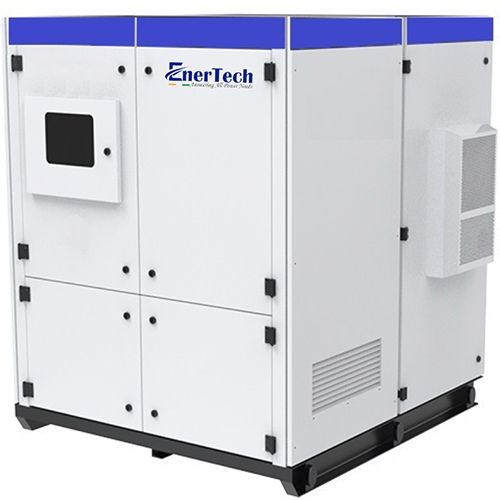Notifications

8 minutes, 3 seconds
-6 Views 0 Comments 0 Likes 0 Reviews

Energy storage solutions are rapidly gaining traction as a key component of modern energy systems. Whether you're a homeowner looking to store solar power or a business aiming to optimize energy consumption, understanding how energy storage works is essential. But how exactly do these systems store and release energy? Let's dive into the mechanics of energy storage solutions and their role in today's energy landscape.
Energy storage refers to the process of capturing energy for later use. It allows you to store energy when it's abundant (like during sunny or windy days) and use it during times of high demand or low production (like at night or during periods of calm).
There are several types of energy storage solutions, each with its own way of capturing, storing, and releasing energy. The most common solutions include batteries, pumped hydro storage, compressed air energy storage (CAES), and thermal energy storage.
At the core of energy storage solutions lies the ability to store energy in a form that can later be converted back to usable power. Here’s a breakdown of how the most common types work:
The most widely used form of energy storage is batteries, particularly lithium-ion batteries. They store energy chemically in the form of electrical charge. Here’s how the process works:
Charging: When energy is available (for example, from solar panels), it is used to convert chemical compounds inside the battery into an electrical charge. This charge is stored in the battery’s cells.
Storage: The battery maintains this stored energy until it’s needed. The energy is retained in the form of chemical potential, ready to be released when required.
Discharging: When energy is needed (say, during the night when solar panels are not generating power), the battery releases the stored energy. The stored chemical energy is converted back into electrical energy and sent to the home, business, or grid.
Advantages: Fast response times, compact size, and high energy efficiency.
Common Use: Home solar power systems, electric vehicles, and grid energy storage.
Pumped hydro storage is one of the oldest and most established forms of energy storage. It works by storing energy in the form of gravitational potential energy.
Charging: During periods of low energy demand, excess electricity is used to pump water from a lower reservoir to an upper reservoir located at a higher elevation.
Storage: The water is stored in the upper reservoir until it’s needed.
Discharging: When energy demand is high, water is released from the upper reservoir. As it flows down to the lower reservoir, it passes through turbines that generate electricity.
Advantages: High energy capacity and long storage durations.
Common Use: Large-scale grid applications and backup energy for utilities.
Compressed Air Energy Storage stores energy in the form of compressed air. Here’s how it works:
Charging: During periods of excess electricity generation, air is compressed and stored in underground caverns or large tanks.
Storage: The compressed air is stored until energy is required.
Discharging: When energy is needed, the compressed air is released. As it expands, it drives turbines that generate electricity.
Advantages: Long storage duration and ability to store large amounts of energy.
Common Use: Large-scale grid energy storage systems.
Thermal energy storage solutions capture energy in the form of heat and store it for later use. The two main types of thermal storage are:
Sensible Heat Storage: Heat is stored by raising the temperature of a material, such as water or molten salt. The higher the temperature, the more energy can be stored.
Latent Heat Storage: Involves the use of phase-changing materials (like ice or salt hydrates), which absorb or release energy as they change from solid to liquid or vice versa.
Charging: During excess energy production, heat is generated and stored in these materials.
Discharging: When energy is needed, the stored heat is used to generate power or heat buildings.
Advantages: Efficient for large-scale energy systems and suitable for industries with high heat demands.
Common Use: Concentrated solar power plants, industrial heating, and district heating systems.
Energy storage solutions play a critical role in ensuring that energy is available when and where it’s needed. Here are some of the key reasons why energy storage is essential:
Renewable Energy Integration: Solar and wind power are intermittent — meaning they don’t generate power all the time. Energy storage allows these sources to contribute consistently to the grid.
Grid Stability: Energy storage systems help balance supply and demand on the grid, ensuring that there’s always enough power for consumers.
Energy Independence: Homeowners with energy storage systems can store solar power and become less reliant on the utility grid, reducing their electricity bills and environmental footprint.
Backup Power: Energy storage solutions provide backup power during grid outages, ensuring that essential services and appliances keep running.
Energy storage is crucial for creating a sustainable, efficient, and reliable energy system. As technology advances, we can expect even more innovative storage solutions, including solid-state batteries, hydrogen storage, and advanced flywheel systems.
With increasing demand for clean energy and the need for more reliable grid systems, energy storage solutions are set to become an essential part of our energy future.
Energy storage solutions are the backbone of the renewable energy transition. They allow us to harness the power of intermittent energy sources like solar and wind and make that power available whenever it’s needed. From residential solar systems to large-scale grid applications, these systems provide the flexibility, reliability, and efficiency required for modern energy demands.

